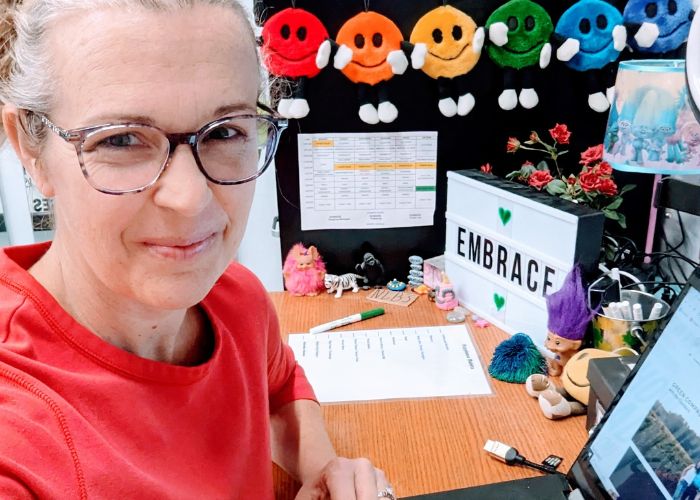Walking into your child’s first IEP meeting can feel overwhelming. I remember sitting in a tiny conference room for my son’s meeting, clutching my notebook and feeling like I was about to take a test I hadn’t studied for. I knew I was there to support him and advocate for the tools he needed to succeed in school but I didn’t know what to expect.
If you’re feeling stressed about it — you’re not alone!
Today, I’m sharing 7 simple, mom-tested tips to help you feel calmer, more confident, and ready to advocate for your amazing child.
1. Understand What an IEP Meeting Is
An IEP (Individualized Education Program) meeting brings together a team of educators, therapists, and YOU — the parent — to create a personalized education plan for your child so they can thrive in school with all the supports, and goals, they need in class.
It’s not a battle. It’s a collaboration focused on helping your child succeed.
2. Gather Your Information
Come prepared with copies of important documents:
- Recent evaluations
- Doctor’s notes
- Teacher emails
- Any outside therapy reports
Make a list of your biggest concerns too — it’s easy to forget things during the meeting. And don’t be afraid to bring it all! I remember hearing this while I pilled up 10 large file folders at one meeting. YOU know your child best and what they need. Don’t be afraid to show your expertise.
3. Know Your Child’s Strengths and Struggles
Before the meeting, jot down 2–3 of your child’s strengths and 2–3 areas where they need support.
This helps the team see the whole child, not just challenges.
This can be a very emotional process, I get it. But remember you are there to HELP your child succeed in school. The team of teachers and staff won’t know what they struggle with (even at home) to help them if you don’t tell them so they can give them the tools they need.
4. Learn Key Terms Ahead of Time
Terms like “accommodations,” “goals,” will come up.
A little preparation can make a big difference — and make you feel more confident!
Accommodations are the ways they will provide for your child within the classroom environment. Like extra time on tests, small group lessons, dual taught classrooms, etc.
Goals are what the team will focus on, to help your child ‘graduate’ by the next IEP meeting. Some of my son’s goals are: Nolan will use effective self-management skills to improve his overall school functioning. And: Nolan will make progress towards remaining on task and completing assignments, ignoring distractions on ipad, with 80% accuracy as measured by observational documents, teacher reports, and assignment completion.
There will also be codes within the IEP. These you should know about as well:
PLAAFP: Present Levels of Academic Achievement and Functional Performance (describes a student’s current abilities and performance in academic and functional areas, including how their disability affects their ability to access and progress in the general education curriculum)
PWN: Prior Written Notice (a legally mandated document that parents in special education receive from the school system when the school proposes to or refuses to take action regarding their child’s identification, evaluation, or educational placement)
LRE: Least Restrictive Environment (a principle in special education, requiring that students with disabilities be educated with their non-disabled peers to the maximum extent appropriate)
BIP: Behavioral Intervention Plan (a formal, written plan designed to address challenging behaviors that interfere with a student’s learning or the learning of others)
5. Write Down Your Questions
Bring a list of questions you want answered, like:
- How will progress be measured?
- How often will I get updates?
- How often is progress assessed?
- Who is on my child’s ‘team’?
- What happens if my child isn’t meeting their goals?
6. Bring Support if You Need It
You can bring a trusted friend, spouse, or advocate to your meeting. Again, you are there to make sure the proper supports are in place for your child to succeed in school, bring anyone you feel can help make that happen. Even just having someone to take notes and be able to have another perspective to talk to can make a big difference.
And if you need a break during the meeting? It’s okay to ask for one!
Kleenex is also a required support to bring. My last meeting did not have any in the conference room and I didn’t have any with me………this IS an emotional process to go through, have the tissues 🙂
7. Remember: You Are the Expert on Your Child
No one knows your child better than you do. Be prepared to stand up and advocate for your child.
Remember also that they may be able to ‘hold it together’ at school but completely break down at home. My son did this. He would not show any struggles or signs of stress at school but completely be a different child for the first hour he got home. School was VERY overstimulating for him. Even if they team does not think supports are needed don’t be afraid to stand your ground so your child can get the breaks they need throughout the day to be more regulated at home.
Trust your voice. Trust your instincts. You deserve a seat at the table — and your input matters more than you know.
Final Thoughts
Your first IEP meeting might feel intimidating, but you are strong, capable, and prepared.
You’ve already been advocating for your child every single day — this meeting is just another step in your journey. If you want a deeper dive into the IEP process, the Autism Moms’ Guide To The IEP Process was created just for you.
You’ve got this, mama. 💛
If you found these tips helpful, share this post with another autism mom who might need a little extra encouragement today!


